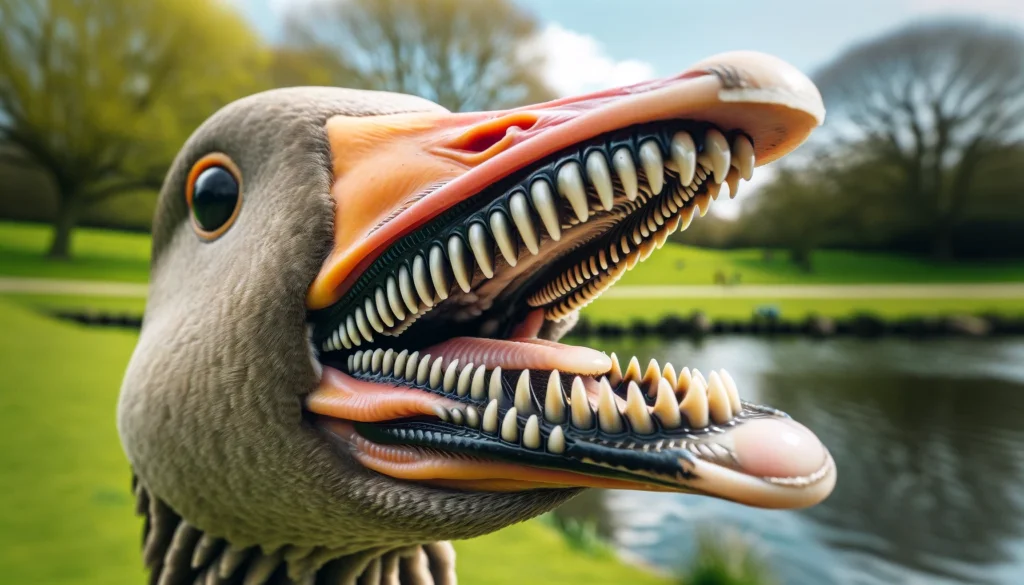When you think of geese, the first thing that might come to mind is their loud honking or aggressive behavior, especially when they feel threatened. But have you ever taken a closer look at a goose’s beak and wondered if those sharp structures are actually teeth? The truth about geese and their so-called “teeth” might surprise you. In this article, we’ll explore the fascinating facts about geese’s unique beaks, their functions, and why they look like they have teeth.
Do Geese Really Have Teeth?
One of the most common misconceptions is that geese have teeth. In reality, geese do not have true teeth like mammals do. Instead, what people often refer to as “teeth” are actually serrations, known as tomia, located on the edges of their beaks. These tomia are sharp, tooth-like structures that help geese grip and tear food, but they are not made of the same material as real teeth.
The tomia are made from keratin—the same substance found in human fingernails and hair. This makes them strong but not as durable or complex as actual teeth. Unlike mammals, birds do not chew their food. Geese use these serrated edges to cut or grab food before swallowing it whole. The presence of tomia allows geese to eat a variety of foods with greater efficiency, from grass to insects.
What Are Tomia and How Do They Work?
Tomia are a specialized adaptation found in many bird species, especially waterfowl like geese, ducks, and swans. These sharp, serrated structures are located on both the upper and lower edges of the beak. While tomia resemble teeth in appearance, they function quite differently.
Geese are herbivores for the most part, feeding on grass, aquatic plants, grains, and sometimes small invertebrates. They don’t need to chew their food, but they do need to cut or grip it firmly before swallowing. The tomia act like little blades or grips, allowing geese to tear up tough plant material or catch slippery prey.
In addition to cutting food, the tomia also help geese defend themselves. If you’ve ever seen a goose chase someone or attack an intruder, you might have noticed it opening its beak aggressively. While the primary defense mechanism of a goose is its wings and feet, the sharp edges of its tomia can deliver a painful bite if it feels threatened.
Why Do Geese Have Serrated Beaks?
The serrations on a goose’s beak are a critical part of its survival. These adaptations provide several important functions, including:
1. Food Processing
Geese eat a variety of plant-based materials, including grass, seeds, and grains, which can be tough to break down. The tomia help them grip and tear the vegetation, making it easier to consume. Even though geese don’t chew like mammals, their beak serrations make it simpler to handle food and swallow it.
When geese feed on aquatic plants, the tomia assist in ripping the plants out of the water or off the pond floor. Without these serrated edges, geese would struggle to tear up tough, fibrous plant material.
2. Catching Prey
While geese are primarily herbivores, they occasionally eat insects and other small invertebrates. The tomia make it easier to catch these small, slippery creatures. For example, when a goose finds a worm or insect, the sharp edges on its beak allow it to grab and hold onto the wiggling prey before swallowing it whole.
This dual function of tearing plants and capturing prey makes tomia a versatile tool for geese.
3. Self-Defense
Geese are notoriously protective of their nests and young. When a goose feels threatened, it often hisses and opens its beak to show off its serrated edges. These sharp tomia can deliver a painful nip, which is usually enough to scare off most predators or perceived threats. While geese rely more on their powerful wings and strong legs for defense, the tomia provide an additional weapon.
4. Communication and Social Behavior
Like many other birds, geese use their beaks in social interactions. Whether they’re grooming each other, establishing dominance, or defending territory, the sharp edges of their tomia can play a role in these behaviors. Geese will often make aggressive displays by opening their beaks and showing off their tomia as a warning to other animals or intruders.
Do Other Birds Have Teeth?
Geese are not the only birds that have serrated beaks resembling teeth. Many waterfowl, such as ducks and swans, also have similar tomia. These birds share a similar diet and environment, which explains why they have developed the same adaptation for food processing and self-defense.
However, no living bird species today have true teeth. Birds evolved from theropod dinosaurs, some of which did have teeth millions of years ago. Over time, birds lost their teeth and developed beaks with specialized adaptations like tomia to suit their dietary needs.
While some birds, like falcons and hawks, have hooked beaks for tearing into prey, others, like geese, have evolved with serrated beaks to handle their specific diets and ecological niches.
Goose Anatomy: Beyond the Beak
The tomia are just one of many fascinating features of goose anatomy. Here are a few other noteworthy aspects of these birds that help them survive and thrive in a wide range of environments:
1. Powerful Wings
Geese are strong fliers, capable of migrating long distances each year. Their wings are powerful and provide both speed and maneuverability. In addition to flight, geese also use their wings to protect their young or defend themselves from predators.
2. Webbed Feet
Like most waterfowl, geese have webbed feet that make them excellent swimmers. These webbed feet help geese move efficiently through water, whether they are swimming for food or evading predators.
3. Sharp Vision
Geese have excellent vision, which is crucial for spotting food and predators from a distance. Their keen eyesight also helps them navigate during long migrations.
4. Vocalization
Geese are known for their loud honking, but their vocalizations serve many purposes. Geese use different calls to communicate with each other, signal danger, or establish territory. Honking is also a way for geese to stay in contact with their flock during migration.
Are Goose Bites Dangerous?
Although a goose’s bite is unlikely to cause serious injury, it can be quite painful. The combination of sharp tomia and strong beak muscles makes a goose’s bite more unpleasant than it might seem. However, geese typically only bite when they feel threatened or are protecting their young.
When encountering geese, it’s best to keep a respectful distance, especially if they are nesting or with their goslings. While they aren’t dangerous animals, geese are highly territorial and will defend their space aggressively if provoked.
Fun Facts About Geese and Their Beaks
- Geese Don’t Have True Teeth: The serrations on their beaks are made of keratin, the same material as our fingernails, and not enamel like mammalian teeth.
- Sharp Tomia Aid in Food Consumption: Geese use their beak serrations to cut through tough plant materials and grab onto slippery prey.
- They Can Bite! While it’s rare for a goose to attack humans, their bites can be quite painful due to the sharpness of their tomia.
- Beak Evolution: Although modern birds don’t have teeth, their ancestors (like some dinosaurs) did. Over time, birds lost their teeth but evolved beaks suited for different diets.
Conclusion
While geese don’t have teeth in the traditional sense, the sharp, tooth-like structures called tomia serve many of the same functions. These serrated edges allow geese to process food efficiently, defend themselves, and maintain their place in the natural world. Next time you see a goose, take a closer look at its beak—you’ll notice how fascinating and well-adapted these birds truly are.
FAQ
Do geese have actual teeth?
No, geese do not have actual teeth. The structures that resemble teeth are called tomia, which are serrated edges made of keratin that line their beaks. These help geese tear up food and grip onto prey.
Can a goose bite you?
Yes, geese can bite, and their bites can be painful due to the sharpness of the tomia. However, goose bites are not typically dangerous unless you have a severe allergic reaction or get an infection.
What are tomia made of?
Tomia are made of keratin, the same substance that forms human hair and nails. These serrated edges are found on the beaks of geese and other birds, helping them tear food and catch prey.
Why do geese hiss at people?
Geese hiss as a warning signal. If they feel threatened or are defending their young, they will often hiss and open their beaks to display the tomia as a way of intimidating potential threats.
Are geese dangerous?
While geese are not inherently dangerous, they are highly protective of their nests and young. If provoked, geese can become aggressive, using their wings, beaks, and tomia to defend themselves.
Do other birds have serrated beaks like geese?
Yes, many waterfowl such as ducks and swans also have serrated beaks. These serrations help them handle food in a similar way to geese, tearing vegetation and gripping slippery prey.


